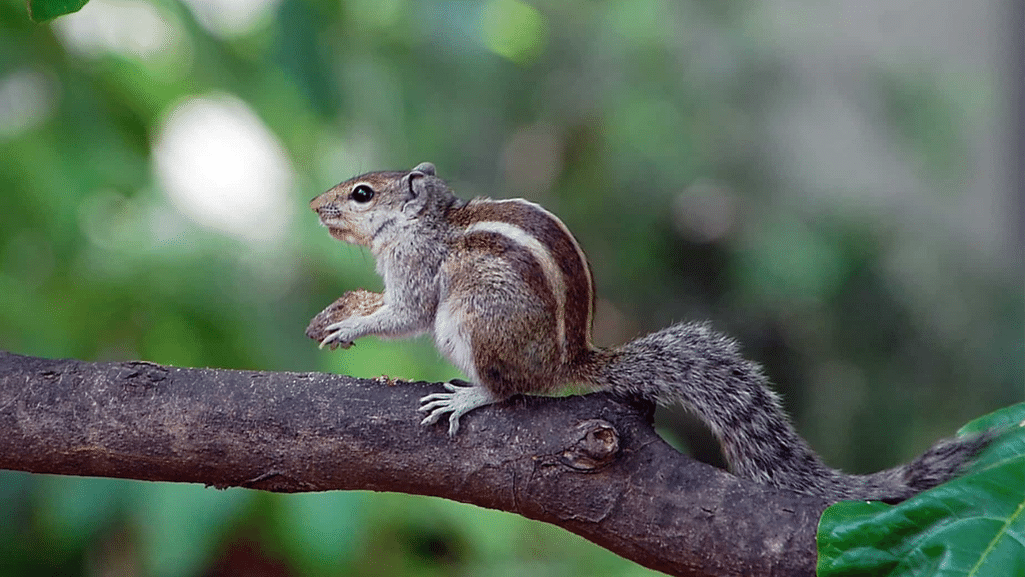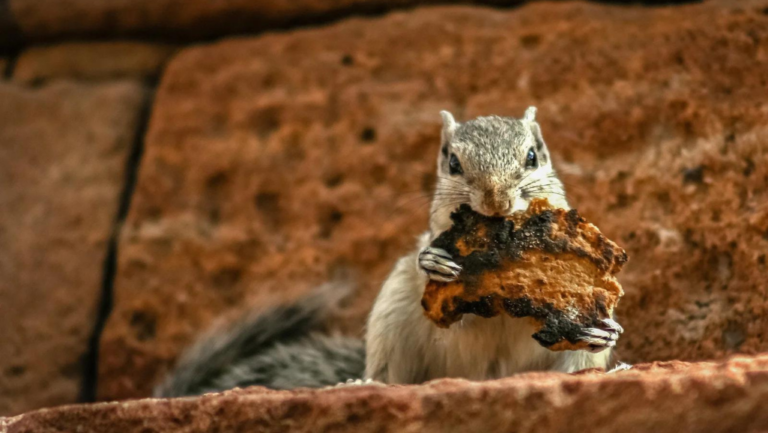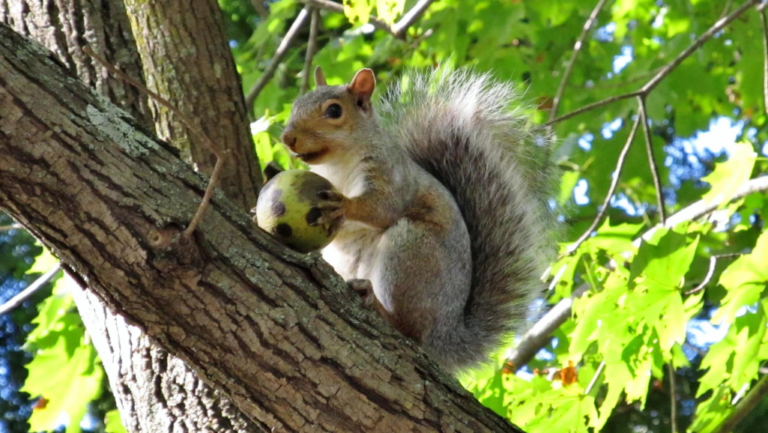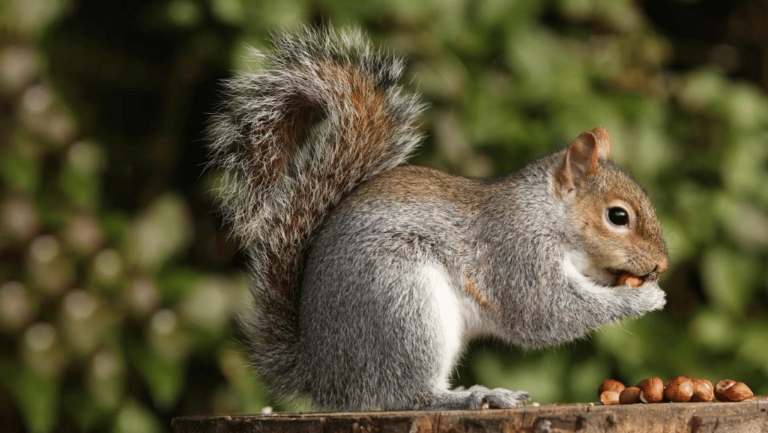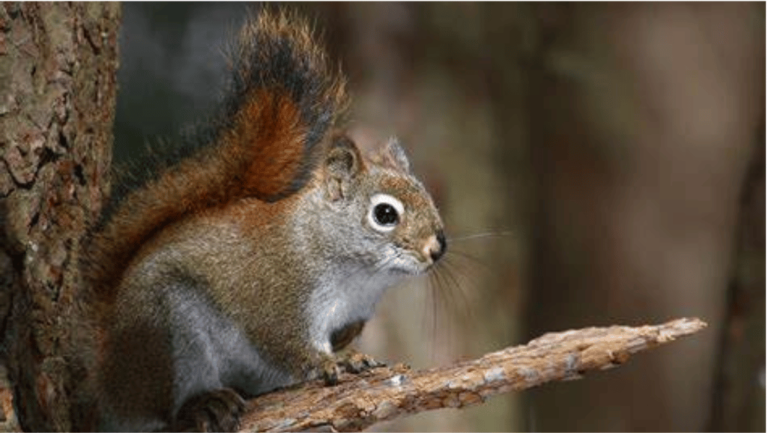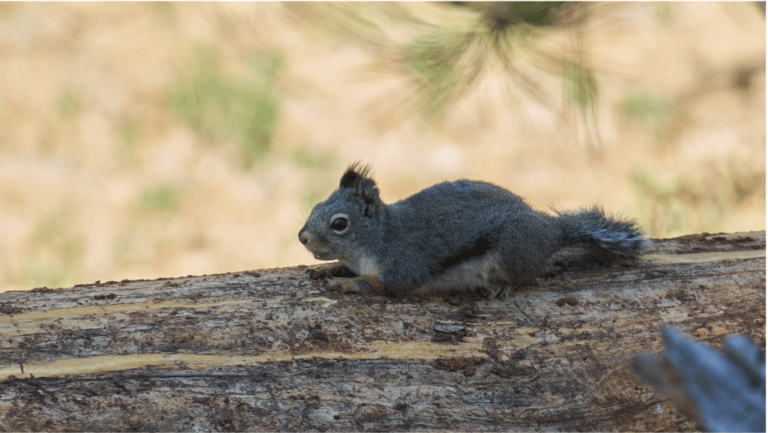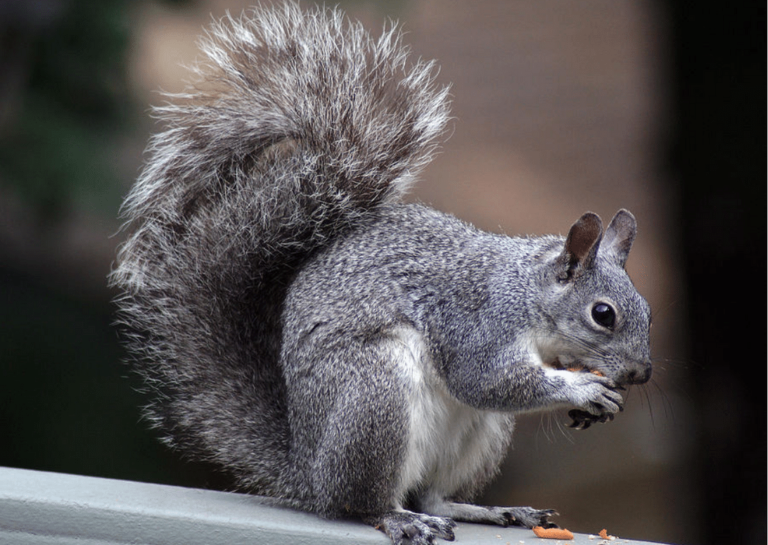The Indian Palm Squirrel, also known as the three-striped palm squirrel, is a fascinating species of rodent native to India and Sri Lanka. This small creature, about the size of a large chipmunk, is an important part of the wildlife in India and is known for its unique behaviors, diverse diet, and adaptable habitat.
Key Takeaways:
- The Indian Palm Squirrel is a rodent species found naturally in India and Sri Lanka.
- It has a grizzled grey-brown back with three white stripes.
- The squirrel is highly adaptable and can be found in various habitats, including forests, gardens, parks, and human settlements.
- Its omnivorous diet includes nuts, fruits, insects, small mammals, and reptiles.
- The Indian Palm Squirrel is primarily solitary but displays bursts of frenzied activity during the mating season.
Habitat of the Indian Palm Squirrel
The Indian Palm Squirrel, a highly adaptable species, thrives in a variety of habitats, making itself at home in forests, gardens, parks, and even human settlements. This seamless transition between natural and urban environments has contributed to its widespread distribution in India. The palm squirrel’s ability to adapt to different habitats showcases its resilience and survival skills.
As an integral part of the Indian wildlife, the palm squirrel adds vibrancy to the ecosystems it inhabits. Whether scampering through the lush foliage of a forest or frolicking amidst the manicured landscapes of urban parks, the Indian Palm Squirrel’s presence is a testimony to the diverse wildlife found in India.
Indian Palm Squirrel Habitat
| Habitat | Description |
|---|---|
| Forests | The palm squirrel can be found in both deciduous and evergreen forests, where it utilizes tree hollows and dense vegetation for shelter. |
| Gardens | With its adept climbing skills, the squirrel appreciates the abundance of trees and shrubs in gardens, providing ample food and shelter opportunities. |
| Parks | Urban parks offer an ideal environment for the palm squirrel, combining trees, grassy areas, and human settlements. |
| Human Settlements | The adaptability of the palm squirrel allows it to coexist with humans, taking advantage of food sources and finding shelter in attics, gardens, and walls. |
The ability of the Indian Palm Squirrel to thrive in diverse habitats, from natural landscapes to urban environments, highlights its remarkable ability to adapt and survive. By being present in a wide range of habitats, this charming creature continues to contribute to the rich tapestry of Indian wildlife.
Diet of the Indian Palm Squirrel
The Indian Palm Squirrel, as an omnivorous rodent species in India, has a diverse diet that enables it to adapt and survive in various environments. The palm squirrel’s diet primarily consists of nuts and fruits, providing it with essential nutrients and energy. These food sources are abundant in the regions where the squirrel inhabits, allowing it to meet its nutritional needs easily.
However, the Indian Palm Squirrel’s diet extends beyond plant-based foods. This resourceful rodent also consumes insects, small mammals, and reptiles, making it a versatile forager. By preying on these smaller creatures, the palm squirrel helps regulate their populations and contributes to the balance of the ecosystem as a whole.
The adaptability of the Indian Palm Squirrel to different food sources reflects its survival skills and ability to thrive in diverse environments. This dietary flexibility has played a significant role in the squirrel’s success as a rodent species in India, enabling it to find sustenance even in changing or challenging conditions.
Indian Palm Squirrel Diet
| Primary Food Sources | Additional Food Sources |
|---|---|
| Nuts | Insects |
| Fruits | Small mammals |
| Reptiles |
Behavior of the Indian Palm Squirrel
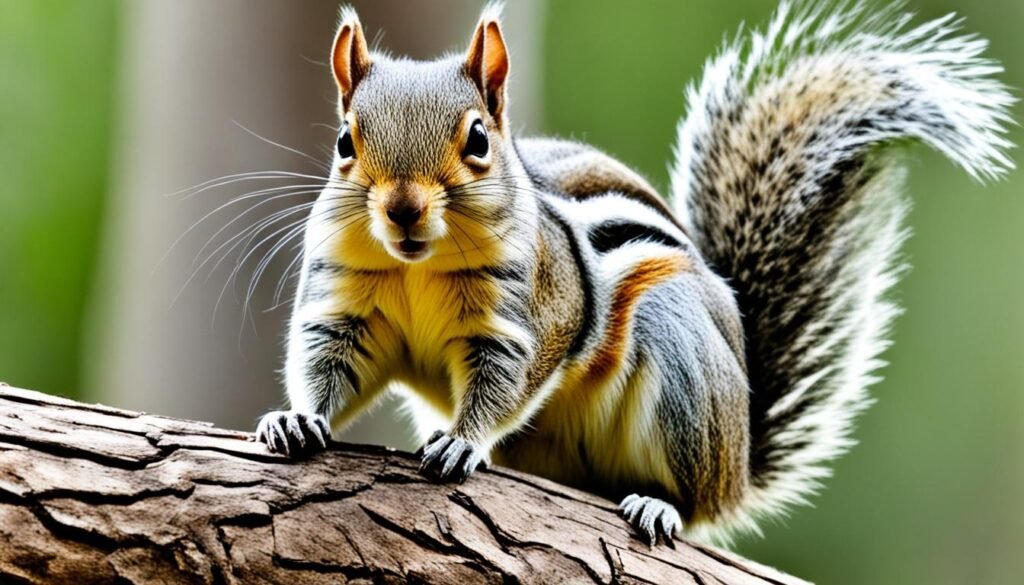
The Indian Palm Squirrel, with its unique characteristics and behaviors, is an intriguing animal to study. While primarily a solitary creature, it engages in limited interactions with others of its kind, particularly during mating and child-rearing. Known for its highly active nature, the palm squirrel can display bursts of frenzied activity, especially during the mating season.
This squirrel species is also territorial and fiercely defends its food sources from other squirrels and birds, exhibiting a strong sense of ownership. When danger is present, the Indian Palm Squirrel emits distinct vocalizations characterized by a rhythmic “chip chip chip” sound, serving as a warning to its counterparts.
These behaviors and characteristics contribute to the survival and adaptation of the Indian Palm Squirrel in its diverse habitats. Understanding the behavior of this species provides valuable insights into its role within the ecosystem.
Conservation Status of the Indian Palm Squirrel
The Indian Palm Squirrel, also known as the three-striped palm squirrel, is currently classified as a species of “Least Concern” by the International Union for Conservation of Nature (IUCN). This designation implies that the Indian Palm Squirrel is not currently facing any significant threats to its population or habitat.
However, the rapid pace of deforestation and habitat degradation in India could pose potential risks to the long-term survival of this unique species. It is crucial to take proactive measures to protect the Indian Palm Squirrel and its diverse ecosystem.
Efforts to Establish Conservation Areas
Conservation organizations and government agencies are actively working towards the establishment of protected areas and wildlife reserves to safeguard the Indian Palm Squirrel and its habitat. By designating specific regions as conservation areas, it becomes possible to regulate human activities and minimize the impact on the squirrel’s natural environment.
These conservation areas also play a vital role in preserving the overall biodiversity of the region, as they provide a safe haven for various plant and animal species, including the Indian Palm Squirrel.
Public Awareness and Education
Creating public awareness and promoting education about the importance of wildlife conservation are crucial aspects of preserving the Indian Palm Squirrel. By educating local communities and raising awareness about the significance of the species, it becomes possible to garner support and involvement from individuals and communities in conservation efforts.
Public participation in conservation initiatives, such as community-led conservation projects or volunteering opportunities, can significantly contribute to the conservation and protection of the Indian Palm Squirrel.
Research and Monitoring
Continued research and monitoring play a vital role in understanding the population dynamics, habitat requirements, and ecological needs of the Indian Palm Squirrel. By conducting scientific studies and monitoring the squirrel’s population trends, conservationists can identify potential threats or changes in their habitat and take appropriate actions to mitigate them.
Research helps to gather critical data that informs conservation strategies and ensures the long-term survival of the Indian Palm Squirrel.
International Cooperation
Collaboration between different countries, organizations, and scientific institutions is essential for the conservation of the Indian Palm Squirrel. Sharing knowledge, best practices, and research findings at an international level strengthens conservation efforts and promotes the sustainable management of natural resources.
International cooperation also enables the exchange of information on conservation strategies, enhances conservation policies, and facilitates the protection of the Indian Palm Squirrel across its range.
| Conservation Measures | Description |
|---|---|
| Establishment of Protected Areas | Designating specific regions as conservation areas to safeguard the Indian Palm Squirrel and its habitat. |
| Public Awareness and Education | Raising awareness and promoting education about the importance of wildlife conservation. |
| Research and Monitoring | Continued scientific research and monitoring to understand population dynamics and habitat requirements. |
| International Cooperation | Promoting collaboration between countries, organizations, and scientific institutions. |
Hindu Legends and the Indian Palm Squirrel
The Indian Palm Squirrel has a special place in Hindu mythology, particularly in relation to Lord Rama. According to an ancient legend, during the construction of the Rama Setu (bridge) by Lord Rama and the monkey army, a small squirrel contributed to the cause. The squirrel would roll in the beach sand and then shake it off at the end of the bridge, helping in its own unique way.
Impressed by the squirrel’s dedication and willingness to contribute, Lord Rama affectionately caressed its back. It is believed that the white stripes on the squirrel’s back are the mark of Lord Rama’s fingers, indicating his appreciation and blessing. This legend is a testament to the reverence and respect the Indian Palm Squirrel holds in Hinduism.
To this day, the Indian Palm Squirrel is seen as a symbol of devotion and a reminder that even the smallest creatures have a role to play. Its presence in Hindu mythology highlights the interconnectedness of all living beings and the importance of every individual’s contribution.
| Indian Palm Squirrel | Lord Rama |
|---|---|
| Small in size | Mighty warrior |
| Contributed to the bridge construction | Led the construction of the bridge |
| Marked by white stripes on its back | Blessed the squirrel with his touch |
| Symbol of devotion | Revered as an incarnation of Lord Vishnu |
Species and Subspecies of the Indian Palm Squirrel
The Indian Palm Squirrel, belonging to the Funambulus genus within the Sciuridae family, is a highly diverse species with several recognized subspecies. These subspecies are classified based on geographical distribution and distinct characteristics, showcasing the rich variety of the Indian Palm Squirrel population.
Recognized Subspecies of the Indian Palm Squirrel
| Subspecies | Geographical Distribution |
|---|---|
| Funambulus palmarum palmarum | India and Sri Lanka |
| Funambulus palmarum brodiei | Southern India |
| Funambulus palmarum robertsoni | Southern India and Sri Lanka |
The Indian Palm Squirrel subspecies, such as Funambulus palmarum palmarum, Funambulus palmarum brodiei, and Funambulus palmarum robertsoni, inhabit different regions of India and Sri Lanka, adapting to the varied environments they call home. The distinctions among these subspecies highlight the complexity and diversity of the Indian Palm Squirrel population.
Conclusion
The Indian Palm Squirrel, a fascinating rodent species native to India and Sri Lanka, plays a vital role in the wildlife of India. With its adaptability and unique behaviors, this squirrel adds vibrancy to the diverse ecosystems it inhabits. Its omnivorous diet and territorial nature contribute to the balance of the ecosystem, making it an integral part of the food chain.
Efforts should be made to ensure the conservation of the Indian Palm Squirrel and its habitat. As human activities continue to encroach upon natural spaces, it is crucial to protect the environment that sustains the wildlife in India, including this wonderful creature. Conserving the population of Indian Palm Squirrels will not only safeguard their existence but also preserve the delicate equilibrium of the entire ecosystem.
The Indian Palm Squirrel’s ability to thrive in different habitats, from forests to urban areas, highlights its resilience. However, it is important to recognize that the squirrel’s adaptability should not be taken for granted. By protecting their habitats and implementing conservation measures, we can ensure the continued survival of the Indian Palm Squirrel and its contribution to the rich wildlife in India.
Frequently Asked Questions
Where can the Indian Palm Squirrel be found?
The Indian Palm Squirrel is naturally found in India and Sri Lanka.
What does the Indian Palm Squirrel eat?
The Indian Palm Squirrel has an omnivorous diet, feeding on nuts, fruits, insects, small mammals, and reptiles.
Is the Indian Palm Squirrel a social animal?
No, the Indian Palm Squirrel is primarily a solitary animal, with limited interactions with others of its kind, except during mating and child-rearing.
What is the conservation status of the Indian Palm Squirrel?
The Indian Palm Squirrel is currently classified as a species of “Least Concern” by the International Union for Conservation of Nature (IUCN).
What is the significance of the Indian Palm Squirrel in Hindu mythology?
According to legend, the Indian Palm Squirrel earned Lord Rama’s admiration and respect for its dedication during the construction of the Rama Setu (bridge).
How many subspecies does the Indian Palm Squirrel have?
The Indian Palm Squirrel is classified into several subspecies, including Funambulus palmarum palmarum, Funambulus palmarum brodiei, and Funambulus palmarum robertsoni.
Why is the Indian Palm Squirrel important?
The Indian Palm Squirrel plays an important role in the ecosystem by contributing to the biodiversity and balance of Indian ecosystems.


